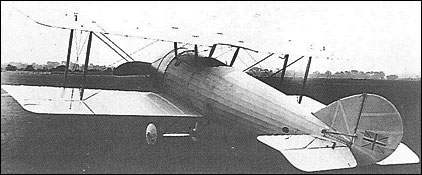|
| Early in 1915, Rex K Pierson was tasked with the redesign of the so-called Barnwell Bullet, an unarmed single-seat biplane designed as a private venture by Vickers' then chief test pilot, Harold Barnwell. Assigned the designation E.S. (Experimental Scout) 1 and completed in August 1915, the redesigned aircraft was powered by a 100hp Gnome Monosoupape rotary and carried no armament. An equi-span single-bay un-staggered biplane, the E.S.1 was aerodynamically clean and possessed an excellent performance, but view for the pilot was extremely poor. An improved version was then developed, powered by the 110hp Clerget nine-cylinder rotary engine. This was assigned the official designation E.S.1 Mk II, although it was known to Vickers as the E.S.2. Two E.S.1 Mk IIs were built, one of these being fitted with a 7.7mm Vickers machine gun with Vickers-Challenger synchronising gear and sent to France in the summer of 1916 for operational trials with No 11 Sqn, RFC. The other E.S.1 Mk II was eventually similarly armed and tested with a 110hp Le Rhone rotary, while the original E.S.1, too, was fitted with the gun and synchronization gear, and was at one time included on the strength of an RFC Home Defence squadron (No 50). The official evaluation of the E.S.1 in both versions pronounced the aircraft tiring to fly and difficult to land, and no production was ordered. The E.S.1 did, however, serve as a basis for the design of the later F.B.19.
| MODEL | E.S.1 Mk II |
| WEIGHTS |
| Take-off weight | 681 kg | 1501 lb |
| Empty weight | 445 kg | 981 lb |
| DIMENSIONS |
| Wingspan | 7.43 m | 24 ft 5 in |
| Length | 6.17 m | 20 ft 3 in |
| Height | 2.34 m | 8 ft 8 in |
| Wing area | 19.97 m2 | 214.96 sq ft |
| PERFORMANCE |
| Max. speed | 180 km/h | 112 mph |
| Klaatu83, e-mail, 06.01.2013 02:34 The pilot was seated between the upper and lower wings, which severely restricted his visibility. That was considered a serious disadvantage for any combat aircraft during World War I. reply | | jack, 18.06.2011 11:04 versions pronounced the aircraft tiring to fly and difficult to land, and no production was ordered. The E.S.1 did, however, serve as a basis for the design of the later F.B.19. reply |
|
Do you have any comments?
|
| 
COMPANY
PROFILE
All the World's Rotorcraft
|







